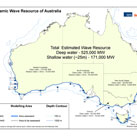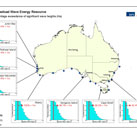
Carnegie Corporation Ltd (Carnegie) is investigating the potential for wave power generation
Wave power is a concentrated and less variable source of renewable energy with the potential to provide baseload electricity supply. The total estimated deep water wave resource for the southern coastal region of Australia, from Geraldton in Western Australia around to the Queensland-New South Wales border, has been estimated to be in the order 500,000MW (Carnegie internal report, 2007). This represents as estimate of the exposed open ocean conditions in water depths greater than 50m, as opposed to the wave resource at 25m water depth where CETO may be deployed.
Carnegie recently commissioned an independent report, from globally recognized ocean resource specialists RPS MetOcean, to provide an independent assessment of the near-shore wave energy resource availability at 17 potential development sites along the southern coastline of Australia. Wave data was sourced primarily from NOAA Wave Watch III (NWW3)modeling and compared to available measured data for seven sites across southern Australia for verification purposes and to examine localized effects on wave power and its availability.
The study indicated that Australia has a potential near-shore wave energy resource of approximately 170,000MW in water depths of 2m (figure 1). This equates to approximately 4 times the total amount of installed power generation capacity nationally. The shallow water wave estimate represents the potentially available resource only and does not take into account the efficiency of extraction by a wave energy conversion device or accessibility of the wave resource.
To demonstrate the potential for baseload power generation, the study also assessed the percentage exceedance for various significant wave heights and periods. The analysis showed that a significant wave height of greater than 1m, above which CETO units generate electricity, occurred for an average of 94% of the time. This demonstrates the suitability of the southern Australian wave resource for baseload power generation (figure 2). Of the near-shore wave resource a conservative 10% is estimated to be economically extractable, which would provide around 35% of Austrlia’s current power demand form zero emission wave energy.
Further site specific wave resource modeling and in-situ wave data collection are recommended in order to build a more accurate picture of the actual extractable resource. In addition an assessment of site specific constraints to development, such as environmental impact, planning regulation and engineering design, will be undertaken on a site by site basis.


